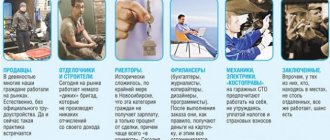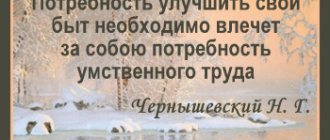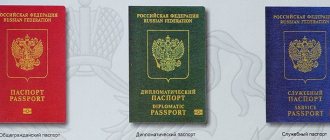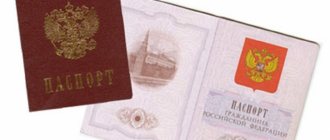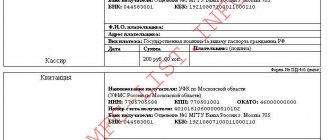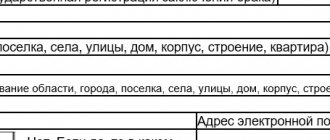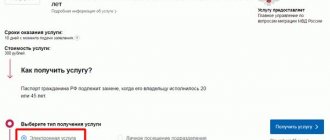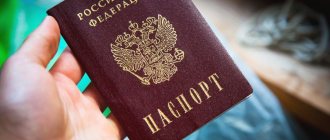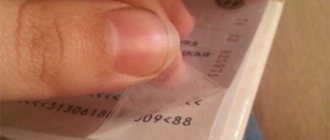What are the signs of a fake passport?
Today, the world is fighting against falsification of documents; countries include Russia, Ukraine, Uzbekistan and others. It is often quite difficult to detect signs of passport forgery, as the level of crime in this area is developing. Identification of false acts can occur through research of technical and forensic significance.
Types of passport counterfeiting
A counterfeit can be one of two possible types:
It is quite simple to distinguish between these concepts, since the first type involves the production of complete documentation. This means that all details, stamps, seals, etc. will be fake. Partial forgery is understood as changing some parts of the paper. Stamps, seals, details, etc. can be changed individually.
A passport can be completely faked using the following methods:
- complete document production;
- production of a form on which the passport is subsequently printed;
- entering information into a document that does not correspond to reality (the person must know about this in advance);
- forgery of the signature of an official of the migration authority who certifies the document;
- production of seals and stamps.
A passport or international passport can be partially falsified by:
- removal of text or part thereof by mechanical means;
- removing text using chemical reagents or solvents;
- introducing new words and characters into the document;
- replacement of individual parts of paper, which could be photos, sheets, etc.
Punishment for carrying out the actions in question is provided for in Article 327 of the Criminal Code of the Russian Federation.
Detecting signs of counterfeit
Speaking about how you can check whether an issued document is an original or a fake, it is worth noting that in practice, the main directions for identifying fakes have been developed:
- Falsified display of details. This method will help to identify which device was used to print the document.
- The color of the letterhead on which the document is printed has changed.
- There are no water images.
- Pages may vary in size.
- On the page, which is laminated, there are no frequently repeated words “Ministry of Internal Affairs of Russia.” To find out whether this inscription exists, you need to examine the document under ultraviolet light.
- When examining the passport under ultraviolet light, there are no fibers that glow green or yellow.
- The microscopic sized elements that make up the lines on the third page are missing.
- The shade of the dye used to make the series and the certificate number do not match.
- There are some poorly printed details in some places.
- Marriage on laminate. Foreign objects may be found under it, for example, earth, etc.
- It is also possible to detect a fake document when the laminate has splitting.
- There are signs of cutting during lamination. They are located at the top of the page.
- You can also recognize a fake if there is damage around the photo.
- Under one photo another may be discovered.
- Double layer of laminate.
- The presence of folds on the flyleaf or cover of the act.
Technical and forensic examination of documents
In some cases, investigations need to determine whether the documentation provided is fraudulent or original. In the second case, it is necessary to determine when and in what way it was performed. For this purpose, a study is being carried out that has technical and forensic significance. Using this study, you can establish:
- what method did the criminals use to produce the passport;
- the fact that the original contents of the paper have been changed;
- damage that is poorly visible or invisible upon inspection;
- the time when the act was prepared;
- by what means the document was falsified.
Recognition of some elements of the forgery can be made by the investigator during inspection and examination of the papers. If the form on which the document is printed is forged, you may notice the following signs:
- the strokes are uneven;
- letters vary in size and configuration;
- the images are of a non-standard nature;
- presence of errors in grammar;
- logical contradictions;
- traces from preparing the document with a pencil.
Important! In the case when we are talking about changing the original content of the passport, there may be traces of washing or etching on it. For this purpose, chemical reagents and other substances are used. The paper in places where it is affected changes its usual color, nearby text may be blurred.
A sign that changes have been made to the text through erasure is that in appearance (if the paper is viewed through a gap), it becomes more precise and rough at the point of erasure. Only the top layer will be damaged
Signs that a document could be falsified by replacing a photo are:
- It is noticeable that the oval and the print text do not match (this happens when the photo is completely replaced).
- Carrying out installation, that is, when part of the old card remains, on which there is a seal, the rest is cut off and another photo is pasted there. A fake can be identified by differences in the photographic paper on which the pictures are printed, the presence of a cut, or mismatched parts of the card.
- A new layer of emulsion is applied to the base of the old photo. This can be detected by the unevenness of the paper and the presence of differences in the quality characteristics of the paper.
Due to the fact that the passport has several degrees of protection, only the signature of the certifying person or the stamp can be forged. This applies to cases where partial falsification of documentation occurs. To identify a fake, a microscope or magnifying glass is used. The study is carried out in obliquely incident rays of light.
What to do if you discover a scam
If it has been discovered that the document used to verify a person’s identity is counterfeit, you need to contact law enforcement agencies. The appeal can be made in the city where the fact of falsification was discovered, in Kazan, Moscow and other populated areas.
Both the person who discovered the fact of forgery and the holder of the false document can apply. It is best to write a statement immediately to the police department, since if you contact the prosecutor’s office about this fact, the document will still be transferred to the named structure for verification.
The application must indicate:
- full name of the body to which the appeal is submitted;
- details of the manager (his last name, initials, rank and position), you can find this out from the duty officer;
- details of the author of the application, a telephone number by which you can contact him must be indicated;
- the circumstances under which the fact of falsification was discovered;
- signature and date.
Article 327 of the Criminal Code of the Russian Federation provides for liability both for falsifying a passport and for using a false document. If a person who has been issued a forged document applies in person, no punishment will be applied unless it is proven that he was aware of the forgery.
What are the signs of a fake passport? Link to main publication
Types of passport counterfeiting
A counterfeit can be one of two possible types:
- partial;
- complete.
It is quite simple to distinguish between these concepts, since the first type involves the production of complete documentation.
This means that all details, stamps, seals, etc. will be fake. Partial forgery is understood as changing some parts of the paper. Stamps, seals, details, etc. can be changed individually. A passport can be completely faked using the following methods:
- complete document production;
- production of a form on which the passport is subsequently printed;
- entering information into a document that does not correspond to reality (the person must know about this in advance);
- forgery of the signature of an official of the migration authority who certifies the document;
- production of seals and stamps.
A passport or international passport can be partially falsified by:
- removal of text or part thereof by mechanical means;
- removing text using chemical reagents or solvents;
- introducing new words and characters into the document;
- replacement of individual parts of paper, which could be photos, sheets, etc.
Punishment for carrying out the actions in question is provided for in Article 327 of the Criminal Code of the Russian Federation.
Covid passport: Roskoshestvo spoke about a new fraud scheme
Roskachestvo specialists spoke about a new type of fraud. Thus, attackers are trying to make money on so-called Covid passports.
As experts explained, scammers offer gullible citizens to purchase such fake documents, claiming that they will be officially introduced in “mid-February 2021,” although discussions about the initiative are still ongoing. To date, the fate of the “Covid passports” has not yet been decided.
As a result, victims give the scammers several thousand, receiving in return just a crust that does not carry any meaning. Often, attackers also ask for a username and password for an account on a government services website in order to gain access to personal data. Subsequently, they can be used for blackmail or for other ways to obtain personal gain through illegal means.
To avoid falling for scammers, experts recommend following simple information security rules. So, first of all, it is necessary to monitor official sources of information - television channels, news agencies, data from the operational headquarters and statements of the Ministry of Health. You should not trust unverified information.
Secondly, it is not recommended to purchase coronavirus vaccines or “Covid passports” over the Internet. Roskoshestvo warned that such a step would be a loss of money only at best. At worst, you can end up under criminal liability.
You also cannot transfer your personal data to anyone on the Internet, including bank card data and login and password from State Services. In addition, you should never panic and open suspicious links.
“Covid scams” are especially common on social media in the form of messages and advertisements. Treat all such messages with distrust, double-check the information and do not transfer money for dubious services in the form of creating certificates and “Covid passports” to individuals , advises Ilya Loevsky, deputy head of Roskachestvo. His words are quoted on the official website of the department.
He noted that in this case it is very difficult to get your money back. Often banks read such transfers simply as a transfer of funds from one individual to another.
NEWS.ru previously wrote that it is impossible to make the rights and freedoms of Russians dependent on a “special certificate”, and medical departments can organize statistics on those who have recovered from COVID-19. This is how the head of the Public Chamber of the Russian Federation, Lidiya Mikheeva, commented on the idea of introducing passports for patients with coronavirus.

